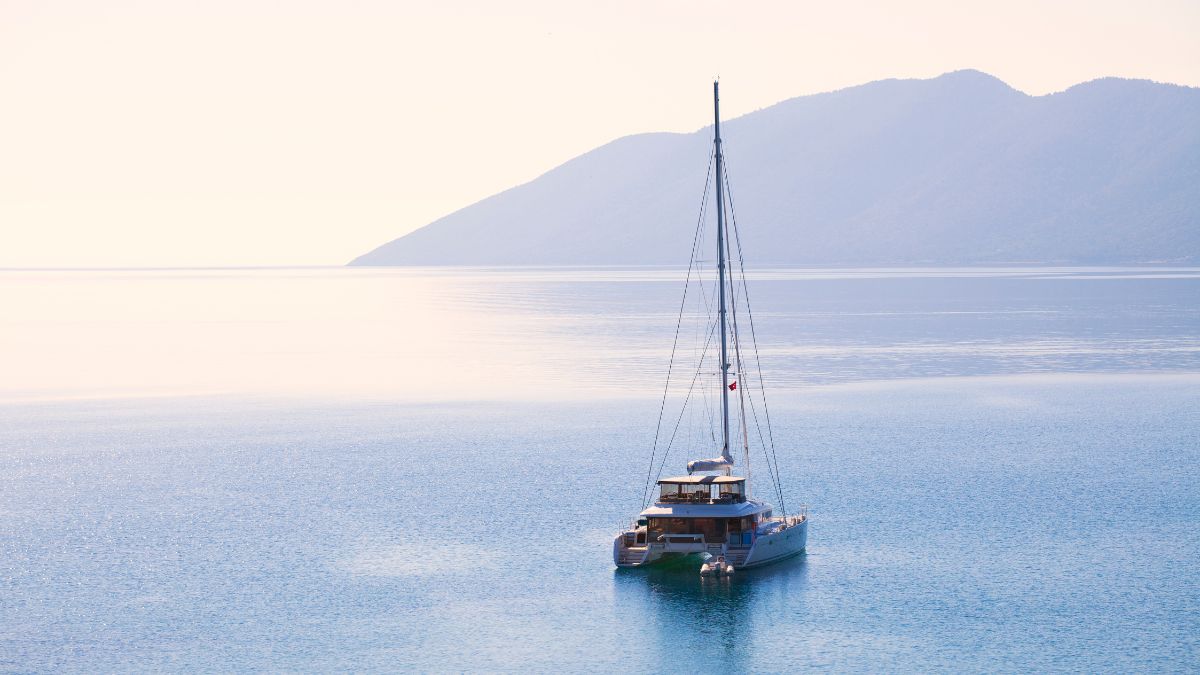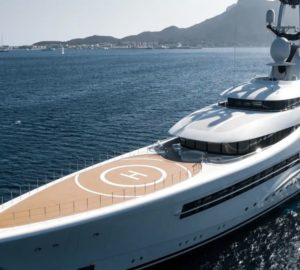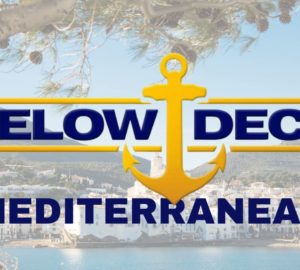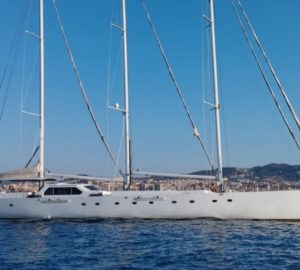When you’re looking at a new yacht, catamarans have clear benefits compared to monohulls. Space, comfort, and ease of handling all tip the scales heavily in favor of a catamaran. But what about choosing power catamarans versus sail? Which type of catamaran is best for you?
Power and sail catamarans both have advantages and drawbacks, and the best choice depends on your needs. Many of them are subjective. For example, if you love to sail, that’s a big plus for a sailing cat. But if speed and a shorter learning curve are your goals, a power cat is an obvious choice. In the end, it comes down to your preferences and how you plan to enjoy your boat.
Power vs. Sail Catamarans – the Main Differences
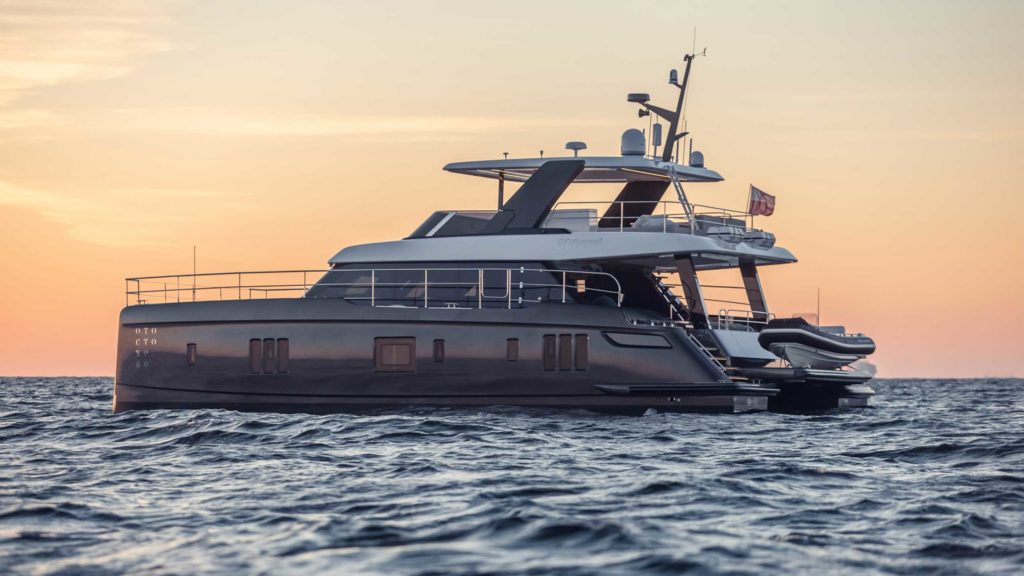
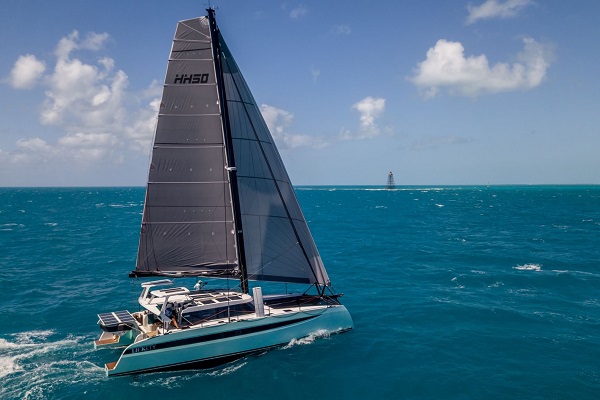
Outside of one having a mast and sails and the other just engines, the more subtle differences come down to skill, space, speed, versatility and ease of use.
The first question you must answer is, do you want to sail? If you know how to sail and love it, this is a straightforward choice. But if you’re a beginning boater, learning to sail is another skill set on top of everything else. And you may not like it. For the dedicated sailor or power boater, the choice may also be clear, so we’ll set that aside those inherent preferences and look for differences for the undecided.
Read also: The luxury Power Multihull guide
Propulsion Choices – Wind and Diesel
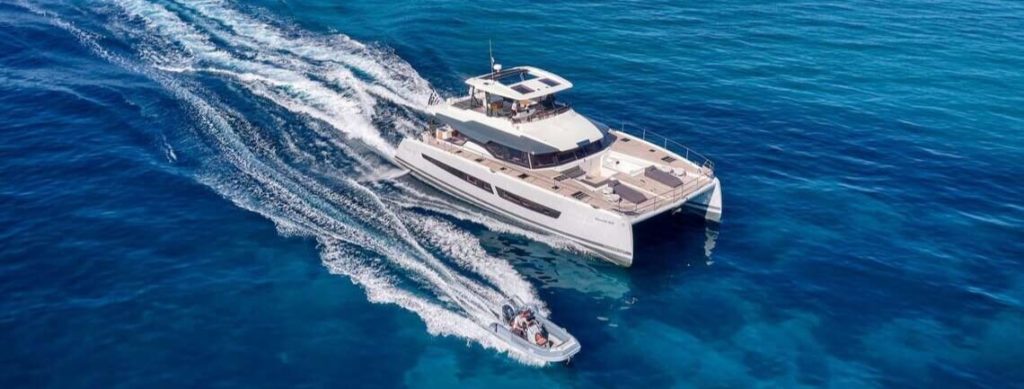
Power catamarans have a pair of powerful engines to drive them everywhere and usually have multiple engine power options to choose from. It’s their only means of propulsion, and they’re designed for high speed and long range. But you will run your engines the entire time you’re moving your boat.
For sailing cats, while wind is the primary propulsion, you can also motor. They have two auxiliary engines for docking and close maneuvers and to keep you moving when the wind dies. But the engines are considerably less powerful on a sailing cat, so your top motoring speeds are lower than a power cat and comparable to mid-range sailing speeds.
If you want wind and diesel as an option, lean towards sailing. But if you want to get there faster and aren’t worried about fuel costs, power is a better choice.
Read also: LAGOON SEVENTY 7: OUR REVIEW OF ONE OF THE BEST CATAMARANS AVAILABLE FOR CHARTER
The Boating Experience
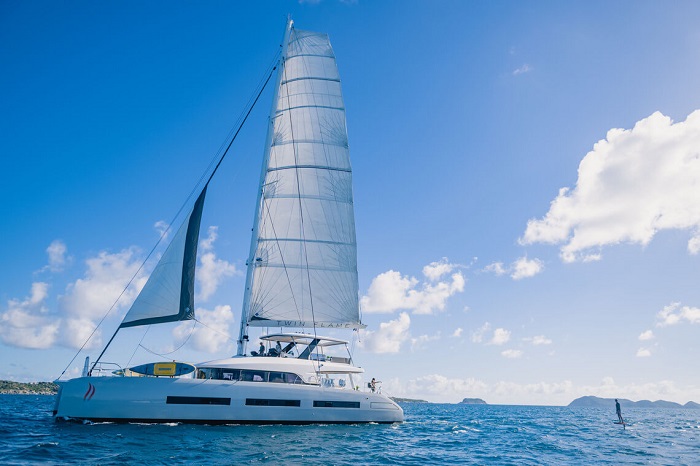
Sailing to your destination is a very different experience than powering. It’s quieter, slower, and it puts you very in tune with the wind, waves, and water. If you love the sensation of sailing, you’ll have a great experience with a sail catamaran that you can not have with a power cat.
Flying across the water at higher speeds, no matter the wind direction, has its own appeal. It’s a distinctive experience from sailing, and that sensation of speed and power at the helm of a faster yacht is hard to match under sail.
Noise and smells
A 250 horsepower engine is louder than a small 45 hp auxiliary, and much louder than the wind. Sailing, you just hear the wind, water, and softer boat noises. Fluttering lines and sails, winches turning, and the hiss of the waves.
With a well-built yacht, you shouldn’t smell diesel fuel. But every engine makes exhaust, and that has to get out of the boat. With the wrong wind direction, you may smell more than you want. Not that sailboats don’t have this problem when motoring, but it’s not as common since the engines run a lot less.
Eco-Friendliness
Sailing yachts use a lot less fuel, even when motoring. When sailing, the fuel consumption to move the boat is zero, except for any generator use on long passages. But the smaller engines on a sailing catamaran also consume far less fuel when you have to use them.
Cruising Range
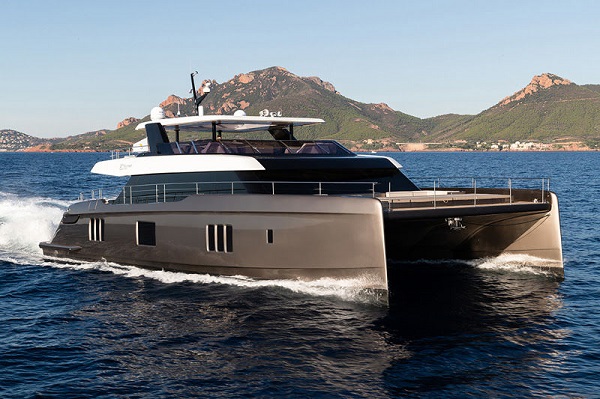
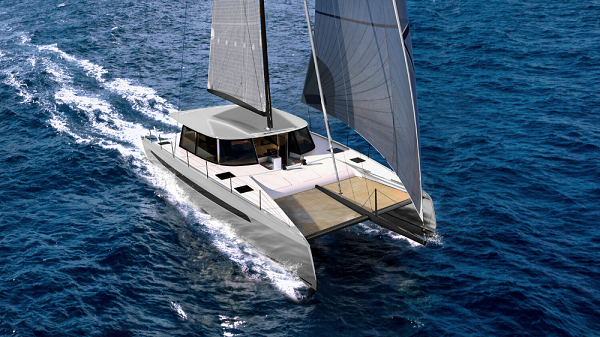
Using wind for fuel has an enormous advantage in cruising range – as long as there is wind, you have fuel. On sailing cat with wind, you only use diesel for charging batteries to keep your lights, refrigeration, and instruments running. Crossing oceans and making long passages is easier with a sailboat.
Not that power cats can’t cross oceans. But you need to bring extra fuel and make sure you keep your engine RPMs and speed in tight optimal consumption ranges. Most boaters looking to cross oceans look to sailboats.
Speed
Power catamarans are the hands-down winner on speed. Since their only propulsion is engines, those are always larger and more powerful than those in similar sized sailing cats. For example, one brand of sailing cat comes with two 45 hp engines, but its similar-sized power cat has options from 250 hp up to 370 hp. Many power cats cruise in excess of 20 knots, while most sailing cats can reach half that only in the best conditions.
Read also: INTRODUCING THE NEW GUNBOAT 72V “WONDERFUL”: THE ULTIMATE PERFORMANCE CATAMARAN
There are exceptions with some brands of high-performance sailing catamarans, but those are not recommended for beginning sailors.
Skill Barriers
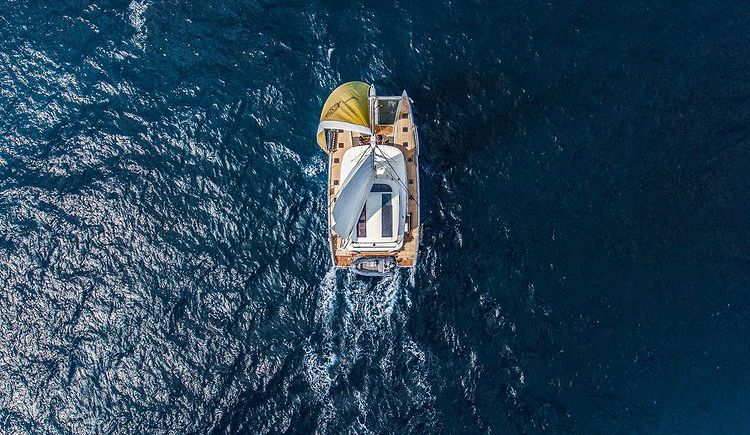
Like chess, learning the basics of sailing is easy, but it takes a long time to master. A short sailing course will have you moving your boat in the right direction in a few hours. But there’s a lot more skill involved in sailing a boat well across a broad range of wind and weather. You need to learn what you’re doing if you plan to sail longer distances efficiently or handle your boat in anything but mild conditions.
It’s not unsurmountable, and learning to sail is rewarding and fun. But if you’re coming to boating with no sailing experience, it can be daunting. Power cats are more beginner-friendly because the skill entry level to powerboats is just lower. The skills for navigation, safety, docking, close maneuvering, anchoring, and mooring are the same for power or sail, but power cats don’t have that extra sailing skill requirement.
Read also: What are the Fastest Cruising Catamaran on the Market?
Operating and Acquisition Costs
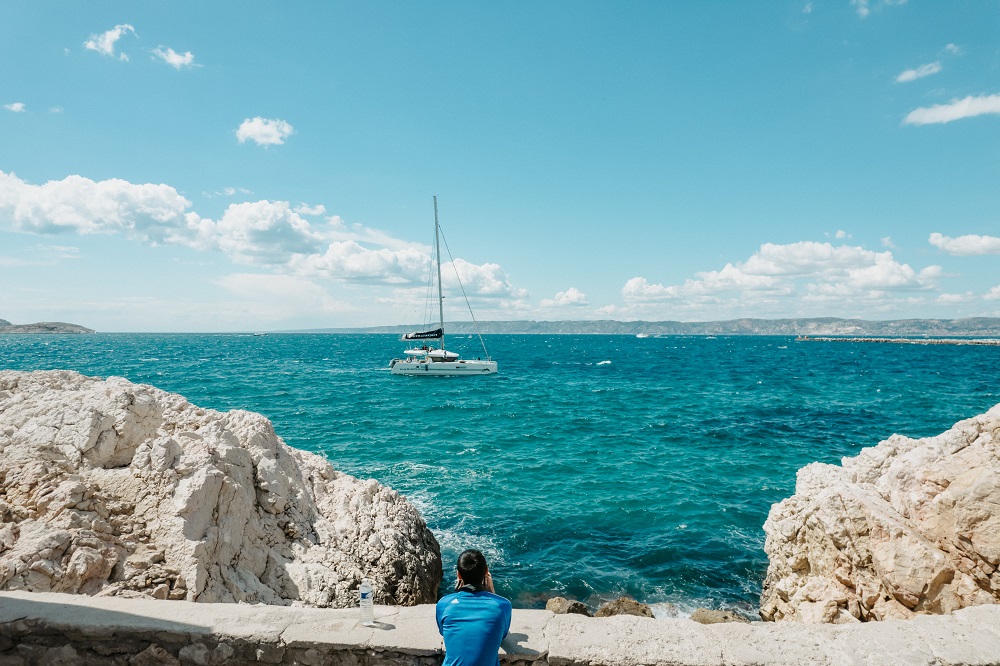
Power catamarans are usually more expensive to buy, as the engines and machinery are more complex and expensive than a sailing rig and sails. For similar reasons, the larger, more complex engines are also more expensive to maintain, and fuel costs are considerably higher. Power catamarans are also more expensive to charter, both in the chartering fees and the fuel costs.
Though sails are expensive, most sails last many years, so sailors only incur this expense at very spread-out intervals.
Deck Space and Bridge Clearance
When you don’t have a mast and boom on the yacht, it’s easier to add flying bridges and more superstructures to gain above-deck living space. A few sail catamaran designs explore flying bridges, but they’re uncommon and only on larger models. And if you’re thinking about taking your catamaran places with bridges and height restrictions, power cats have little trouble with trips like the Great Loop, the Intracoastal Waterway, or even some of the European canals.
Summary Table
| Criteria | Power catamaran | Sailing catamaran |
| Propulsion | Engine only, but fast | Wind and auxiliary engine |
| Eco-friendliness | Low | High |
| Speed | High speed | Slower under sail and power |
| Range | Limited by fuel capacity | Based on wind |
| Boating sensation | High speed powerboat | Sailing closer to nature |
| Ease of operation | Easy | Requires sailing skills |
| Noise | Louder when moving | Quiet under sail |
| Smell | Chance of exhaust smells | Only salty breeze when sailing |
| Convenience | Quick moves between destinations | Slower to move |
| Cost to use / own | More fuel costs, higher maintenance | Low fuel costs |
Our advice for the undecided
While we can’t decide for you, our experts have a few suggestions to steer you in the right direction. From years of experience talking to boat owners and handling charters, we’ve learned a few things.
• If living space and comfort primarily draw you to catamarans, a power cat may be the best choice.
• If you love sailing and the sailing experience, you’re likely to be happiest in a sailing cat.
• For the ultimate in convenience and ease of travel, a power catamaran will not disappoint you.
• For flat-out speed and quick moves between anchorages, a power cat wins.
• If you’re looking to cruise the world, a sailing catamaran may work better.
• And finally, if budget is one of your constraints, sailing may be a better choice.
Can you convert a sailing catamaran to a power cat?
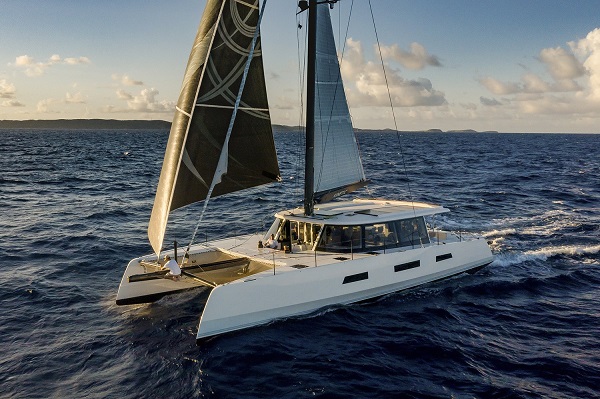
You can always remove the mast from a sailing catamaran, but does that make it a power cat? Yes and no. It would take sailing out of the equation, so technically it would be a power catamaran.
However, the engines in a sailing catamaran are smaller than power cat engines, and the power cat propulsion system delivers high speed and performance. Sailing cats can not keep up on motoring speed, and they aren’t designed to. While taking the rig out of a sailing cat will make the boat lighter and give it a little speed boost, it won’t be close to the experience you’d have with a true power catamaran.
One could remove the sailing rig and re-power the boat with larger engines. But there are space and design constraints which may make this prohibitively expensive. Trying to put a 250 hp engine into a space designed for 50 hp may prove impossible, and lead to a boat which is ill-suited to the intended purpose.
So while you can make a conversion, there is serious doubt as to the advisability of it if your goal is power catamaran performance. You may end up spending a lot of money on a project that can not satisfy you.
Making the right choice
Armed with a list of pros and cons for each, the next steps are to talk to some experts at an experienced yacht brokerage or new boat dealer, and look at some boats.
If you have the time and budget for it, the best thing to do is get out on each type of catamaran and see for yourself, whether it’s a day trip with a captain or a week on a bareboat. Dedicated sailors who spend a week on a power cat may love it, and new boaters and power boaters sailing for the first time may discover a brand new passion.
What’s most important in the decision is figuring out what you want and need from your boating experience, and how the sail versus power decision best fits your dreams, plans, and budget.

